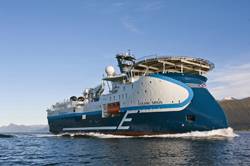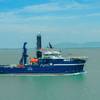ULSTEIN Delivers Seismic RV
ULSTEIN delivered the seismic research vessel Oceanic Sirius to Eidesvik and CGGVeritas on 3 October. Oceanic Sirius is designed and built in accordance with strict environmental standards and equipped with state-of-the-art technology for advanced seismic research operations. She is owned by a joint venture between Eidesvik and CGGVeritas. The vessel was named in a ceremony in Ulsteinvik on 1 October. Oceanic Sirius is sister vessel to the Oceanic Vega, delivered by ULSTEIN in July 2010.
“We are proud to deliver a vessel that features among the most advanced seismic research vessels in the world, and we are confident that she will stand the owners in good stead for many years to come, says managing director of Ulstein Verft, Karsten Sævik.
Eidesvik is recognized for its focus on green solutions and dedication to the development of environmentally sound ships. CEO of Eidesvik, Jan Fredrik Meling, comments on their latest ship: “We are pleased to take delivery of another vessel of ULSTEIN quality; a vessel designed and built to minimise harmful emissions to the environment whilst offering the best possible working environment for our seafarers. This is the third X-BOW vessel we now own and based on the performance of the first two, Viking Poseidon and Oceanic Vega, we have great expectations for the Oceanic Sirius.”
CGGVeritas is known as an innovative, responsible and high-end provider of geophysical technologies, services and equipment. Jean-Georges Malcor, CEO of CGGVeritas, says: “We look forward to the Oceanic Sirius matching the excellent seismic performance of her sister ship, the Oceanic Vega. She has been designed for optimum propulsion and seismic reliability to ensure minimum of operational downtime. Her outstanding qualities will make her a valuable addition to the CGGVeritas seismic fleet.”
Oceanic Sirius is the second of two vessels of the SX120 type designed by Ulstein Design & Solutions. She is a powerful seismic research vessel with a dynamic towing force of 140 tons. The vessel is ideally suited for acquisition of large 3D, 4D or high-resolution projects. The vessel´s 20 streamer winches are each capable of spooling 9 kilometres of streamers. Carrying an ICE-C classification, the Oceanic Sirius can operate in new frontier areas.
Efficient
Oceanic Sirius is designed to stay permanently at sea with five-year docking intervals. There are enough engines and generator sets on board to conduct maintenance at sea and refuelling is carried out by dedicated support vessels. The vessel is equipped with two CP (controllable pitch) propellers in a nozzle, each driven by two frequency converter-driven electric motors. This allows smooth speed control of around five knots during seismic acquisition. Two work boats will be used for maintenance of in-water equipment.
Oceanic Sirius complies with the Clean Design demands as well as the redundant propulsion notation from DNV. The vessel’s redundant propulsion system ensures that propulsion and steering remain intact after failure in parts of the system. Diesel electric propulsion reduces fuel consumption and atmospheric emissions. In addition to modern systems for sludge, garbage and sewage handling, a complete ballast water treatment system has been installed on board. The system prevents the spreading of marine organisms from one geographic area to another with the ballast water, a cause of potentially serious ecological, economical and health problems in the host environment.
Crew comfort
Oceanic Sirius complies with the IMO code of safety for special purpose ships (SPS code) for up to 70 persons. She is a high-standard comfort class vessel with an internet cafe, a gymnasium and a sauna. There are 52 single cabins and only nine double cabins on board. The mess room, galley and the four dayrooms have large windows facing the sea to add comfort for the crew. The vessel is equipped with a helideck to facilitate an efficient crew change. The X-BOW® hull line design results in lower added resistance and smoother bow immergence, leading to reduced operational disturbance and involuntary speed reduction.
Modern
The ship’s instrument room, with its ergonomically designed interior, is located at the stern with large windows facing the sea. It is placed directly above the seismic area, with a direct view of the streamer deck. A storage area above the instrument room is served by a knuckle jib crane with a capacity of 10 tons at 20 metres outreach. The two offshore cranes placed on C-deck mid-ship have a capacity of 15 tons at 18 metres outreach and can be used to lift supplies on board from service vessels.
Ulstein Power & Control has delivered a substantial amount of equipment for the vessel, including the information and communication system ULSTEIN COM®, the navigation system ULSTEIN NAV, and the integrated automation system ULSTEIN IAS, which is equipped with integrated modules, among them PMS (power management system) and modules for monitoring of the helideck and the ballast water treatment system.












